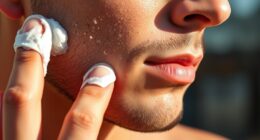Across cultures, attitudes towards tanning vary widely. In Western societies, a tan often signifies wealth, leisure, and health, influenced by media, celebrities, and fashion trends. Meanwhile, East Asian cultures traditionally favor fair skin, symbolizing purity and social status. Globalization and media continue shaping beauty ideals, blending traditional preferences with modern trends. Gender and socioeconomic factors also play roles in skin color standards. To understand how these varied perceptions develop and evolve, explore further insights below.
Key Takeaways
- Cultural attitudes toward skin tone vary globally, with some societies valuing fair skin as a symbol of beauty and status, while others associate tanned skin with health and leisure.
- In Western cultures, tanning became popular as a sign of wealth and leisure during the 20th century, shifting from manual labor to modern luxury.
- Traditional societies, such as in Japan and Thailand, historically associate fair skin with nobility and purity, influencing beauty standards.
- The spread of Western beauty ideals through media and globalization has led to diverse perceptions of tanning and skin color across different regions.
- Socioeconomic and gender factors shape tanning practices and beauty standards differently worldwide, often reinforcing social inequalities related to skin tone.
Historical Attitudes Toward Skin Tone in Western Societies

Historically, Western societies have linked lighter skin to higher social status and moral virtue, a connection rooted in colonial and racial hierarchies. Colonizers used this association to justify oppression and slavery, assigning lighter-skinned enslaved people to domestic roles and darker-skinned individuals to outdoor labor. Even after slavery ended, systems continued to favor those with Euro-centric features, granting them better education and property rights. Scientific racism further cemented skin color as the primary racial marker, often portraying white traits like rationality and civility as superior, while stereotypes depicted dark skin as savage or inferior. These beliefs reinforced social stratification, making skin tone a key factor in determining one’s place in society. This legacy of racial bias shaped perceptions of morality, civility, and worth for generations. Additionally, the influence of racial stereotypes persisted into modern media and cultural representations, continuing to impact societal attitudes toward skin tone. Recognizing how these historical attitudes have shaped current prejudices is essential to understanding ongoing issues related to racial discrimination and skin color bias. Furthermore, the social construction of race has played a significant role in shaping these perceptions throughout history. Moreover, understanding the origins of these perceptions can help inform efforts to promote racial equality and challenge ingrained stereotypes, which are often perpetuated by media portrayals that reinforce outdated narratives.
The Evolution of Tanning as a Symbol of Wealth and Leisure

During the Industrial Revolution, as urbanization took hold, the meaning of a tan shifted from a sign of manual labor to a marker of leisure and wealth. Factory work kept the working class indoors, while elites accessed sunlight during their leisure time, making tanning a symbol of status. Medical awareness of sunlight’s health benefits by the early 20th century redefined tanned skin as healthy. Coco Chanel’s accidental tan in 1923 glamorized bronzed skin, associating it with luxury travel and sophistication. Beach resorts and advertising further linked tans to vitality and affluence. As sunbathing became accessible and fashionable, a tan transformed from a sign of hard labor to an emblem of leisure, wealth, and modern elegance. The perception of tanning evolved alongside advancements in understanding the health effects of sunlight, further cementing its status as a symbol of affluence. Additionally, the development of tanning technologies like artificial tanning methods contributed to the widespread adoption of the tanned look. Moreover, cultural influences across different societies have shaped the evolving ideals of beauty related to skin tone. The desire for a consistent, sun-kissed appearance also led to the rise of self-tanning products, making tanning more accessible regardless of geographic location or climate. This shift was supported by innovations in sound design techniques that helped promote the glamour and allure of tanned skin in advertising media.
Preferences for Pale Skin in East Asian Cultures

Why do many East Asian cultures prize pale skin so highly? Historically, pale skin signified higher social status because it meant you avoided outdoor labor, which darkened skin. In rural societies, darker skin was linked to poverty and manual work, while elites maintained a lighter complexion to showcase privilege and refinement. Colonial influences and Western beauty standards further reinforced the idea that whiteness symbolized power and wealth. Cultural texts and literature from Japan, Thailand, and other East Asian countries have long celebrated fair skin as a mark of beauty and nobility. Today, media and advertising continue to promote pale skin as desirable, shaping social attitudes and creating pressure to conform. The preference for paleness remains deeply rooted in history, culture, and social hierarchy, with beauty ideals often emphasizing the importance of skin tone as a symbol of social identity. Additionally, modern cosmetic products such as skin whitening creams and treatments have become widely popular, perpetuating these longstanding standards.
The Impact of Media and Celebrity Culture on Tanning Trends

Media and celebrity culture play a powerful role in shaping modern tanning trends, often glamorizing bronzed skin as a symbol of beauty and success. Television, reality TV, and social media showcase tanned celebrities and influencers, creating aspirational images that influence viewers to follow suit. Platforms like Instagram and TikTok make tanning appear trendy and fun, with influencers promoting sun-kissed looks to large teen audiences. Unfortunately, misinformation spreads easily online—encouraging risky practices like seeking sunburns or using low SPF products. Celebrities endorsing tanning routines normalize bronzed skin, often overshadowing public health messages. Despite awareness campaigns, the glamorization persists, reinforcing tanning as a desirable lifestyle choice. As a result, media-driven images heavily influence how many people perceive and pursue tanning today. The appeal of a glowing complexion is often amplified by media portrayals, further encouraging the pursuit of tanned skin despite health risks.
Additionally, the media’s influence can sometimes obscure the health consequences associated with excessive sun exposure, making it harder for individuals to make informed choices. This pervasive celebrity influence often leads to a skewed perception of tanning as both glamorous and essential for attractiveness. Moreover, the normalization of tanning in popular culture can diminish awareness of the potential for skin damage and skin cancer, leading to a misguided pursuit of beauty.
Health Perceptions and Public Awareness of Sun Exposure Risks

Public awareness of the risks associated with sun exposure varies widely around the world, often influencing people’s behaviors and perceptions about tanning. In many developed countries, higher skin cancer rates have increased awareness, but gaps remain, especially among outdoor workers and adolescents. You might notice that some people, particularly young women, still prioritize tanning despite the health dangers. Many underestimate eye damage risks from UV rays, and awareness of skin cancer links isn’t universal. Cultural attitudes often favor tanned skin as attractive, undermining warnings. While some recognize UV exposure can cause sunburn and premature aging, others view sun exposure as essential for vitamin D, complicating public health messages. Overall, understanding of UV risks is inconsistent, making it challenging to promote safe sun habits globally. Additionally, public health campaigns aimed at educating populations about sun safety vary in effectiveness across different regions. Recognizing how sunscreen use and protective clothing influence risk perception can enhance the effectiveness of these initiatives. Moreover, behavioral factors play a significant role in whether individuals adopt sun safety practices despite known risks. Increasing awareness about the health effects of UV exposure, including both skin cancer and eye damage, remains a critical component of effective public health strategies.
Cultural Shifts Due to Globalization and Cross-Cultural Influences

Globalization has considerably reshaped how different cultures perceive and pursue tanning, with Western beauty standards spreading worldwide through various channels. Media, advertising, and Hollywood have long popularized tanned skin as a sign of glamour and health, influencing perceptions globally. Social media accelerates this trend, exposing diverse audiences to bronzed looks and sunless tanning products. In some cultures, where fair skin once symbolized social status, tanning is now embraced as a desirable trait, creating hybrid beauty ideals. Young people, in particular, adopt tanning to align with global images of beauty. This cross-cultural exchange encourages new tanning methods and shifts norms, blending traditional preferences with modern trends. As perceptions evolve, some cultures experience tension between embracing global beauty standards and maintaining indigenous skin color ideals. Additionally, the integration of interior design elements, such as incorporating antique-inspired decor, reflects the broader cultural shifts towards blending tradition with modern influences. The cultural exchange surrounding beauty practices highlights how interconnected our world has become. Furthermore, the adoption of modern beauty trends influences local industries and consumer behaviors, fostering a dynamic interplay between tradition and innovation. Recognizing the importance of cultural adaptation can help societies balance tradition with evolving global standards. This shift is also evident in the way traditional aesthetics are now being reinterpreted through contemporary design influences.
Socioeconomic and Gender Dimensions of Skin Color Ideals

Socioeconomic and gender factors deeply influence how skin color ideals shape your life and opportunities. If you have lighter skin, you’re more likely to enjoy higher income levels, better education, and greater occupational prestige. These advantages often lead to intergenerational benefits, giving lighter-skinned families long-term socioeconomic gains. Gender also plays a pivotal role—women, in particular, face stronger pressures to conform to beauty standards favoring lighter skin. This can impact marriage prospects, self-esteem, and media representation, often reinforcing stereotypes that equate lighter skin with beauty and success. Cultural biases and historical perceptions have ingrained these ideals, influencing access to resources and social acceptance. These dynamics perpetuate inequalities, making skin color a significant factor in social stratification and personal opportunity.
Modern Innovations and Market Responses to Diverse Beauty Standards

Modern innovations in tanning reflect a growing desire to meet diverse beauty standards while prioritizing safety and sustainability. You’ll find personalized spray tans that match your skin tone naturally, and new formulas that combine skincare benefits with color. Eco-friendly products are rising in popularity, aligning with environmentally conscious values. Advanced tanning beds now use smart UV controls, sensors, and cooling systems to minimize risks and improve comfort. Instant tan products satisfy the need for quick, temporary results for events or social outings. Market responses include more inclusive color guides, natural-looking finishes, and safer tanning options. Consumers favor occasional, healthier tans over long-term solutions, pushing brands to develop sustainable packaging and innovative products. These changes reflect a market adapting to diverse beauty ideals with technology and eco-awareness at the forefront.
Frequently Asked Questions
How Do Indigenous Cultures Perceive and Value Skin Tones Differently From Western and Asian Standards?
You might notice that indigenous cultures often see darker skin as a symbol of resilience, resistance, and cultural pride, contrasting with Western and Asian standards that favor lighter skin. While Western and Asian societies sometimes associate pale skin with beauty and status, indigenous communities value darker tones for spiritual roles, ancestral ties, and community strength. This difference underscores how skin perception reflects deeper cultural identities and histories.
What Role Does Climate and Geography Play in Shaping Regional Tanning and Skin Lightening Practices?
Did you know that 95% of U.S.-connected tanneries operate overseas to avoid strict environmental laws? Climate and geography heavily influence regional tanning and skin lightening practices. In tropical areas with high UV exposure, people often seek sun protection or embrace tanning, while colder regions see more indoor tanning or skin-lightening efforts. Altitude, cloud cover, and weather patterns further shape these behaviors, reflecting local environmental challenges and cultural adaptations.
How Do Religious or Spiritual Beliefs Influence Attitudes Toward Skin Color in Various Societies?
Religious and spiritual beliefs markedly shape how societies view skin color. You might notice that some traditions associate lighter skin with purity, beauty, or divine favor, while darker skin can be linked to sin or iniquity. These perceptions often stem from historical teachings or interpretations that reinforce social hierarchies and biases. As a result, your community’s attitudes toward skin tone can be deeply influenced by these religious and spiritual ideals.
Are There Traditional Skincare Rituals Linked to Skin Tone Preferences in Non-Western Cultures?
You’ll find that many non-Western cultures have traditional skincare rituals focused on achieving and maintaining specific skin tones. For example, Japanese and Korean practices emphasize light, luminous skin through hydration, brightening ingredients, and gentle cleansing. Middle Eastern rituals prioritize hydration and glow with rose water and argan oil, while African traditions use nourishing oils for resilience. These rituals reflect cultural ideals of beauty, health, and identity, shaping how people care for their skin.
How Does Migration and Diaspora Affect Evolving Beauty Standards Around Skin Color Globally?
Migration and diaspora markedly influence beauty standards around skin color worldwide. You should know that lighter-skinned immigrants earn about 17% more than their darker-skinned peers, highlighting persistent colorism. As you move or interact with diverse communities, you’ll see how cultural ideals blend, challenging or reinforcing traditional biases. This process creates hybrid standards, where exposure to new norms can promote acceptance or deepen divisions based on skin tone, shaping social and economic opportunities for many.
Conclusion
As you explore the diverse meanings of skin tone across cultures, you see how history, media, health, and globalization shape perceptions. You recognize how preferences evolve, how societal ideals influence individual choices, and how modern innovations respond to these changing standards. You understand that beauty standards are complex, fluid, and interconnected—shaped by tradition, influenced by media, and transformed by globalization—reminding you that embracing diversity in skin tones enriches our shared human experience.









